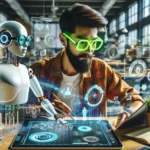Artificial intelligence (AI) mimics human intelligence in computers to do tasks like learning, problem-solving, and decision-making, which typically require human cognitive capacities. This blog post examines how artificial intelligence enhances efficiency and creativity in the creative sectors of writing, music, and art. Since AI can completely transform how we create and consume art and culture and represents broader societal tendencies toward integrating cutting-edge technology into everyday life, it is crucial to comprehend how it impacts these creative sectors.
AI in Art
AI in Art has revolutionized the field, moving away from conventional techniques and towards AI-driven works. Though historically, human talent and creativity have been the foundation of art, AI technologies like DeepArt and Google DeepDream now produce visual art, opening up new creative avenues. These technologies allow users to create original works that combine several styles and components by analyzing and learning large databases of already created artworks. Innovation and the capacity to go into new creative horizons are two advantages of AI in the field. Still, there are issues, like moral questions about the genuineness and originality of artwork produced by AI and worries about the possible eviction of human artists.
AI in Music
AI in music has developed dramatically, revolutionizing the processes of production and composition. Previously, the only means of producing music was human imagination, but now, AI technologies like AIVA and Amper Music help with song development, melody composition, and even track mastering. By making music creation easier and more effective, these programs enable producers to experiment with many sounds and genres fast. However, AI also creates questions even if it has many advantages, like accelerating the creative process and creating new opportunities. The consequences for conventional musicians and composers and the loss of human touch and inventiveness in AI-generated music are still open questions.
AI in Literature
In literature, AI signals a change from conventional human-centered writing to AI-assisted techniques, bringing content production tools like GPT-3 and Jasper. These tools alter language, improve plotlines, and provide suggestions to expedite the process. AI increases publishing and editing productivity as well. Still, there are difficulties. Even as AI increases speed, worries regarding the originality and quality of the material still exist. Furthermore, there are ethical concerns about creativity and the possibility of AI taking on the role of human authors.
AI in Entertainment and Gaming
AI is even making its way into our entertainment and gaming sectors. Real money gambling from home has made the USA online casino sector quite popular. States that regulate and allow online gaming include Michigan, Pennsylvania, and New Jersey, which guarantee player safety and compliance. Popular USA online casinos for real money include a wide selection of games and easy-to-use features. AI is improving security through algorithms, customizing game suggestions, and working as customer service bots or even as a personal assistant. AI plays a vital role in security and safeguarding players – acting as the security guard before you even log into your account.
Cross-Disciplinary Impact
The fascinating nexus between art, music, and literature created by artificial intelligence results in creative group projects and multimedia creations. AI-driven technologies allow authors, musicians, and artists to combine their fields in previously unheard-of ways, producing more immersive and participatory works. These partnerships demonstrate how artificial intelligence (AI) may influence the creative sectors of the future by expanding the bounds of what is feasible and promoting a new age of multidisciplinary creativity. Its function in these multidisciplinary initiatives will grow as AI develops, creating even more opportunities for creativity and innovation.
Ethical and Societal Implications
Important ethical and sociological problems are raised by the use of artificial intelligence in creative domains. As works produced by AI question established ideas of creativity and ownership, intellectual property and authorship become complicated. Concerns exist about how AI’s potential could affect established authors, musicians, and artists, who might feel threatened. Ensuring that technology improves rather than replaces human contribution requires striking a balance between the promise of AI and human inventiveness. It takes this balance to preserve the special worth of human creation while using AI to push the boundaries of literature, music, and art.
Conclusion
In conclusion, incorporating artificial intelligence into literature, music, and art signals a revolutionary change in the creative sectors. AI is changing our conception of the ability to produce art, from creating elaborate music and visual masterpieces to helping to write gripping stories. Though there are obstacles, including moral dilemmas and the harmony between human and machine creation, there is room for creativity and novel ways of expression. Understanding and sensibly using AI’s potential requires continuous conversation and investigation. A richer cultural environment and fascinating advancements may result from accepting AI’s creative function.

